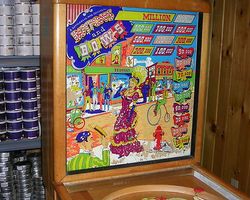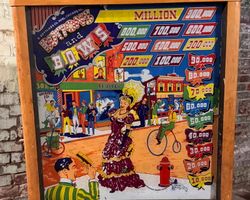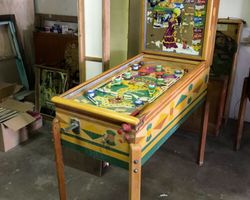Buttons and Bows

Average Prices: USD $300 to $700
Produced: March, 1949
Production Run: 2,200 units
Machine Type: Electro-mechanical
Players: 1
Design by: Harry Mabs
Art by: Roy Parker
Pinball machines of the electro-mechanical (EM) era often encapsulate the inventiveness and unique charm of their time. Among these, Gottlieb's "Buttons and Bows," released in April 1949, stands as an example of thoughtful design and engaging gameplay from the industry’s mid-century prime. Manufactured by D. Gottlieb & Co., a company known for its prolific output and innovative mechanical designs, this single-player machine entered a vibrant market, showcasing the evolving complexities of pinball entertainment.
History and Background
"Buttons and Bows" emerged from the creative collaboration characteristic of Gottlieb’s development process. Designed by Harry Mabs, a significant contributor to many popular Gottlieb titles, the machine reflects his ability to conceive intricate and compelling play experiences. Mabs, working alongside the broader Gottlieb engineering crew, infused "Buttons and Bows" with mechanical innovations that distinguished it within the 1949 lineup. The visual identity of the machine was crafted by Roy Parker, whose artistic touch adorned the backglass. Parker’s work on "Buttons and Bows" is often cited for its beauty, contributing significantly to the machine's overall appeal.
The production run for "Buttons and Bows" amounted to 2,200 units. While this figure positioned it as a reasonably successful title for the period, it also meant the machine was not as widely disseminated as some of Gottlieb’s later blockbusters. Its release as model number 19 in Gottlieb’s extensive catalog occurred in March 1949. This era marked a crucial period for pinball, as manufacturers experimented with new features and scoring mechanics to captivate players. The machine's internal mechanics, particularly its stepper units, were complex for the time, hinting at the sophisticated engineering behind its seemingly whimsical facade. This internal intricacy, while posing challenges for maintenance and restoration, also contributed to the fascinating depth of its gameplay.
Signature Features and Design
"Buttons and Bows" distinguishes itself through a collection of features that collectively shape its distinct gameplay. Paramount among these are the "step-up buttons," achieved through activating specific rollover switches on the playfield. These rollovers either increment the value of certain game elements or extinguish a series of five green "dead bumpers." The interplay between increasing values and eliminating targets creates an engaging dynamic, encouraging precision and strategic shot placement.
The "dead bumpers" themselves are a central element, their value capable of escalating from 10,000 to 50,000 points once activated. This escalating value adds a layer of risk and reward; players must decide whether to pursue the higher-value shots or focus on activating other features. However, the most talked-about and arguably defining feature of "Buttons and Bows" is its integration of "reverse flippers." Unlike standard flippers that propel the ball forward, these flippers manipulate the ball in an unconventional manner, challenging player expectations and forcing a rethinking of traditional pinball technique. This unique mechanical choice contributes to a playing experience described as psychologically stimulating, adding an unexpected layer of difficulty and novelty. The backglass, with Roy Parker’s artwork, serves as a visual anchor, complementing the playfield's interactive elements and setting the thematic tone.
Playfield and Mechanics
The playfield of "Buttons and Bows" is designed around its core mechanical features, encouraging players to master new approaches to ball control and target engagement. While specific details on ramps or a multitude of targets are not noted, the presence of the two rollovers for the "step-up buttons" implies distinct lanes or pathways players must navigate. The five green "dead bumpers" would have been strategically placed to provide both scoring opportunities and obstacles, requiring careful aiming to either activate them or pass by them for other objectives.
The central challenge and fascination of the playfield derive from the "reverse flippers." Their unique action dictates a different rhythm of play. Instead of the familiar upward flick, players would have to adapt their timing and control to the reverse motion, which could send the ball in unexpected directions, including potentially back down the playfield faster. This design choice fundamentally alters the flow of the game, demanding heightened player focus and dexterity. The overall aesthetic, from the playfield art to the general layout, would have adhered to Gottlieb’s prevalent style of the late 1940s—clean lines, vibrant colors, and clear demarcation of scoring opportunities, all contributing to player immersion within the game's unique mechanical framework.
Gameplay Dynamics
The gameplay dynamics of "Buttons and Bows" revolve around adapting to its distinctive mechanics. The "step-up buttons" system serves as a primary progression path, urging players to hit specific rollovers to either enhance scoring potential or clear targets. Maximizing the value of the "dead bumpers" from 10,000 to 50,000 points by successfully hitting them before they extinguish becomes a key objective, offering substantial point bonuses for skilled players.
However, it is the implementation of the "reverse flippers" that truly defines the strategic depth of "Buttons and Bows." Players accustomed to traditional flipper behavior must fundamentally alter their timing and anticipation. A shot that might be a simple pass on a conventional machine becomes a deliberate, calculated maneuver with reverse flippers. This challenges established muscle memory, requiring players to develop new techniques for trapping, nudging, and accurate shot placement. The interplay between managing the unique flippers and strategically activating the step-up buttons to maximize bumper values creates a dynamic experience. Successful players would learn to leverage the reverse flippers not just to keep the ball in play, but to guide it precisely towards the rollovers or the high-value dead bumpers. This necessitates a fluid understanding of the ball's physics under reverse propulsion, making each game a unique test of adaptation and precision.
Reception and Legacy
"Buttons and Bows" generally garners a very positive reception within the pinball community, particularly among enthusiasts of electro-mechanical machines. Its strengths are frequently cited as its high entertainment factor and smooth gameplay, despite the unconventional flipper mechanic. The machine's design, attributed to Harry Mabs and the Gottlieb engineering team, is often commended for its ingenuity, specifically regarding the "step-up buttons" and the escalating dead bumper values. Roy Parker's backglass art is consistently highlighted as a beautiful example of his work, adding to the machine’s aesthetic appeal.
The most notable aspect of its reception revolves around the "reverse flippers." While presenting a learning curve, these are largely appreciated for providing a unique and "psychologically thrilling" challenge that distinguishes "Buttons and Bows" from its contemporaries. The machine's internal complexity, particularly its large and intricate stepper units, is acknowledged as a challenge for maintenance and restoration, yet it is also seen as a testament to the sophisticated engineering of the era, contributing to the game's enduring fascination. Some observers express surprise that "Buttons and Bows" has not received more widespread recognition from collectors of early pinball games, suggesting it remains somewhat underrated despite its innovative features and engaging play. Its legacy rests on its status as a testament to Gottlieb’s willingness to experiment with fundamental gameplay mechanics, offering an experience that stands apart in the broad history of electro-mechanical pinball.
Sponsored Links
 Ebay Listings
Ebay Listings
 Auction Results
Auction Results
| Cost | Location | Date |
|---|---|---|
| USD $1,450 |  Ohio, United States Ohio, United States |
12 September, 2024 |
| USD $300 |  Arizona, United States Arizona, United States |
08 September, 2019 |
| USD $910 |  Pennsylvania, United States Pennsylvania, United States |
11 November, 2016 |
| USD $405 |  Vermont, United States Vermont, United States |
30 September, 2011 |
| USD $238 |  Virginia, United States Virginia, United States |
16 September, 2011 |
| GBP £300 |  Wiveliscombe, United Kingdom Wiveliscombe, United Kingdom |
04 July, 2011 |
| USD $500 |  United States United States |
11 May, 2001 |


Private Policy · Search Website · Contact Us
As an eBay Partner, we may earn a commission from qualifying purchases made through links on this site, at no additional cost to you.
All trademarks and copyrighted materials remain property of their respective owners. All other content copyright 2007 - 2026 Pinpedia.



